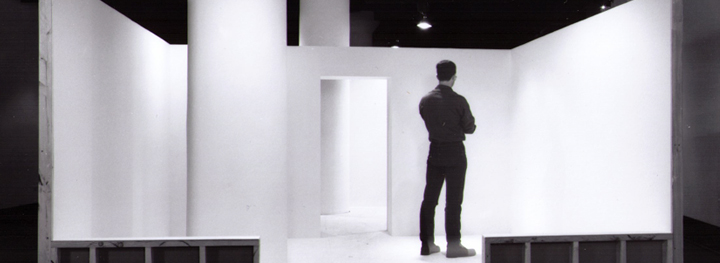Art & Art History
& how too

The installation & how too is a critical analysis of an art gallery as a neutral white room. Using Gallery 400 as a backdrop, artist Mike Hill and architect Scott Kester, as the Art Builders Collaborative (ABC), explore the relationship between the production of artwork and the creation of physical space in which art is exhibited. Within the Gallery 400 space, ABC will build a three-quarters scale version of Robbin Lockett Gallery using standard building materials and methods, thus essentially re-creating a commercial space in an exhibition context. Displayed as art object, the gallery reveals its particular idiom of design and construction, exposing and exaggerating its stillness by uncovering the inherent art/architecture relationship that lies within it. Murals illustrating the step-by-step process of building the gallery are painted on Gallery 400’s walls; the murals will be documented by a professional art photographer before they are painted over. ABC’s exhibition includes the photo-documents of the instructions before they were painted over—adding to the layers of art shows past. Simultaneously, the exhibition space is demystified through the exposure of its physical creation, and it is revealed as an important record of exhibition history—of the physical absence of artworks. As shows come and go, the walls remain superficially the same: spackled, repainted, ready for the next.
The exhibition gallery currently enjoys the reputation of a malleable site for contemplation and reflection. Seemingly architecturally mute and static, it sets the stage for art to take the starring role. The archetype of this particular piece (Robbin Lockett Gallery) responds to the connection between the architectural features, which compose the environment, and the sociohistoric events, which have taken place in it. By exploring the region of interiors, its relationship to and effect upon the external and visiting public, the Gallery 400 exhibition space acts as a metaphor for the potential of a stimulus (usually provided by an exhibition) in the absence of it.
Continuing their efforts to explore existing relationships between physical space and individual memory, the collaborative manipulates traditional materials and forms, spurring a rich and ample dialogue and blurring current distinctions between art and architecture as independent influences on the exhibition experience. The format and use of materials in & how too is modest and raw and serves successfully as camouflage as well as embellishment. The materials of the piece, due to their usual pedestrian employment, yet sleek aesthetic appeal, speak to the connection between the organic and the static, in addition to that between the essence of objects and their manifestations. This stripping away of the preciousness from the elusive, utopian gallery space by using simple, disclosed operations alludes to ABC’s idea of process uncovered and its subliminal effect on the viewer ’s experience.
The framework for & how too is based on elements of transformation, exchange, displacement, and past representation that depends on associative meanings. The deconstruction of the space facilitates recognition of previous spaces and events. In recent installations, ABC’s investigations have addressed the excavation of a fictitious gallery/exhibition history. In past installations, Hill and Kester sanded parts of walls, uncovering wall drawings by Sol LeWitt, dozens of layered artist’s names announcing shows, and constellations of monthly nail holes. These projects have dealt with that which is hidden, which lies beneath gallery efforts to clear space from evidence of past events, freeing it for new ideas, experiences, and innovations. On this behalf, the collaborative uses the gallery wall to juxtapose fragmented structural elements of (hypothetical) exhibitions past with the cover of the newly repaired and, as yet, unadulterated white surface. This deconstruction successfully recontexualizes the viewer ’s recognition of pre-existing spaces or events, hence revealing the relationship between structure and memory and initiating a dialogue concerning the origin of one and the conclusion of the other. & how too seeks to build upon this rhetoric between reflection and recollection as well as to further reveal the considerable affinity between the construction of intellectual notions and physical structures.
EXHIBITION SUPPORT
& how too is supported by the University of Illinois at Chicago School of Art and Design’s College of Architecture, Art, and Urban Planning.
This exhibition is also partly funded by the Illinois Arts Council, a state agency.
PRESS RELEASE
Art Builders Collaborative (Mike Hill and Scott Kester)
& how too
Gallery 400
Chicago, Illinois
January 13–31, 1992
ARTISTS BIOGRAPHIES
 Scott Kester (born 1964) is an artist and architect who lives and works in New York City. He has developed the concept Handmade Architecture, which combines the craft and personal touch of custom fabrication with the foresight required of traditional design and planning. While teaching at the University of Illinois at Chicago, he designed and built residential projects and developed a conceptual sculpture installation practice. His own practice has developed many successful international brands, including Sushi Samba and Lotus. His work has been widely published. Kester graduated from the University of Michigan with a BA in art history in 1985. He received his MArch from the Harvard GSD in 1989, where he built his thesis project on Gund Hall.
Scott Kester (born 1964) is an artist and architect who lives and works in New York City. He has developed the concept Handmade Architecture, which combines the craft and personal touch of custom fabrication with the foresight required of traditional design and planning. While teaching at the University of Illinois at Chicago, he designed and built residential projects and developed a conceptual sculpture installation practice. His own practice has developed many successful international brands, including Sushi Samba and Lotus. His work has been widely published. Kester graduated from the University of Michigan with a BA in art history in 1985. He received his MArch from the Harvard GSD in 1989, where he built his thesis project on Gund Hall.
EXHIBITION CHECKLIST
Mike Hill and Scott Kester
& how too, 1992
Collaborative installation